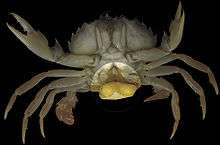Parasitic castration
Parasitic castration is the strategy, by a parasite, of blocking reproduction by its host, completely or in part, to its own benefit. This is one of six major strategies within parasitism.

For example, Hemioniscus balani, a parasitic castrator of hermaphroditic barnacles, feeds on ovarian fluid, so that its host loses female reproductive ability but still can function as a male.[2] This is a case of direct parasitic castration (feeding on host gonads). Indirect strategies are also seen such as diverting host energy from gonad development or secreting castrating hormones.[3]
The parasitic castration strategy is used by some larval trematode parasites of snails and some isopod and barnacle parasites of crustaceans.[4] For example, 18 species of trematodes are known to parasitically castrate the California horn snail, Cerithidea californica.[5]
Evolutionary considerations
A parasite that ends the reproductive life of its host theoretically liberates a significant fraction of the host's resources, which can now be used to benefit the parasite. Lafferty points out that the fraction of intact host energy spent on reproduction includes not just gonads and gametes but also secondary sexual characteristics, mate-seeking behavior, competition, and care for offspring.[4] Poulin suggests that prolonged host life may also result from parasitic castration, benefiting the parasite.[3]
Parasitic castrators and parasitoids
The parasitic castration strategy, which results in the reproductive death of the host, can be compared with the parasitoid strategy, which results in the host's death. Both parasitoids and parasitic castrators tend to be similar to their host in size, whereas most non-castrating parasites are orders of magnitude smaller than the host. In both strategies, an infected host is much less hospitable to new parasites than an uninfected one.[6]
Taxonomic range
| Parasite group | Parasite species | Host group | Host species | Remarks |
|---|---|---|---|---|
| Protista Sporozoa | Mackinnonia tubificis | Annelida Oligochaete | Tubifex tubifex | Destroys gonad[6] |
| Protista Haplosporidia | Urosporidium charletti | Cestoda | Catenotaenia dendritica | "Hypercastrator" (a hyperparasite that castrates the parasite it parasitizes)[6] |
| Platyhelminthes Trematoda | Bucephalus mytili | Mollusca Bivalvia | various species | Destroys gonad, host grows larger[6] |
| Platyhelminthes Cestoda | various species | Pisces Cyprinidae | various species | Destroys gonad, behavioral changes[6] |
| Arthropoda Isopoda | Hemioniscus balani | Arthropoda Cirripedia | various barnacles | Drains ovarian fluid of hermaphrodite, but spares male function[2] |
| Arthropoda Cirripedia | Sacculina | Arthropoda Decapoda | various crabs | Atrophies gonads, behavioral changes, partially feminizes males and stops regeneration of crab legs[6] |
| Arthropoda Strepsiptera | twisted-wing flies | Arthropoda Hymenoptera or Hemiptera | various species | Males feminized, females produce no eggs but instead disperse eggs of parasite[1] |
| Platyhelminthes Cestoda | Flamingolepis liguloides | Arthropoda | Artemia spp. | Destroys gonads, behavioral changes[7] |
| Arthropoda Hymenoptera | Crematogaster sjostedti | Plant | Acacia drepanolobium | Ant removes axillary meristems, sterilizing trees.[8][9] |
References
- Zimmer, Carl (August 2000). "Do Parasites Rule the World?". Discover. Retrieved 19 February 2011.
- Blower, S. M.; J. Roughgarden (1988). "Parasitic castration: host species preferences, size-selectivity and spatial heterogeneity" (PDF). Oecologia. 75 (4): 512–515. doi:10.1007/BF00776413. Archived from the original (PDF) on 2016-03-04. Retrieved 2011-02-11.
- Poulin, Robert (2007). Evolutionary Ecology of Parasites (2nd ed.). Springer. pp. 106, 111–114. ISBN 978-0-691-12084-3.
- Lafferty, Kevin D.; Armand M. Kuris (2009). "Parasitic castration: the evolution and ecology of body snatchers". Trends in Parasitology. 25 (12): 564–572. doi:10.1016/j.pt.2009.09.003. PMID 19800291.
- Hechinger R. F. (2010). "Mortality affects adaptive allocation to growth and reproduction: field evidence from a guild of body snatchers". BMC Evolutionary Biology. 10: 136. doi:10.1186/1471-2148-10-136. PMC 2887408. PMID 20459643.
- Kuris, Armand M. (1974). "Trophic interactions: similarity of parasitic castrators to parasitoids" (PDF). Quarterly Review of Biology. 49 (2): 129–148. doi:10.1086/408018.
- Yong, Ed (January 2013). "Parasites Make Their Hosts Sociable So They Get Eaten". National Geographic. Retrieved 6 December 2016.
- Stanton, M. L.; Palmer, T. M.; Young, T. P.; Evans, A.; Turner, M. L. (1999). "Sterilization and canopy modification of a swollen thorn acacia tree by a plant-ant". Nature. 401 (6753): 578–581. doi:10.1038/44119.
- Hall, S. R.; Becker, C.; Caceres, C. E. (2007-05-22). "Parasitic castration: a perspective from a model of dynamic energy budgets". Integrative and Comparative Biology. Oxford University Press. 47 (2): 295–309. doi:10.1093/icb/icm057.